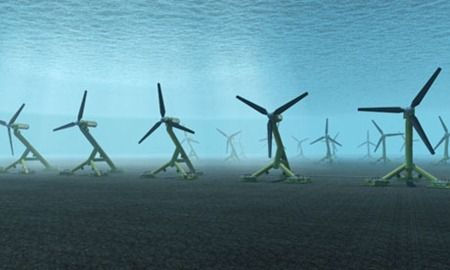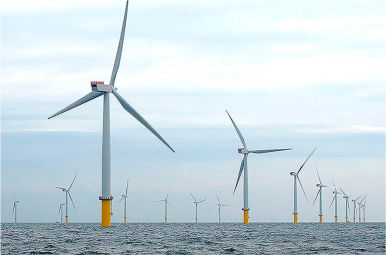After green comes blue
- Science-by-Trianon

- May 2, 2021
- 4 min read
Everybody is talking about 'green energy'.
Attentive followers of all things environmental might have come across the term 'blue energy'.
What does blue energy mean?

Generating electricity from funnelling rivers from their springs in the mountains downhill through turbines is an old hat, however, it is somewhat restricted to mountainous areas, which is bad news for places like The Netherlands.
On the other hand, the Dutch are no strangers to water, everything but.
For centuries they have defended their land against the sea which is constantly gnawing away at their shores and threatening to flood the land.
Is there a way to harness the power of the waves rolling onto the beaches?
Or harnessing the power of the sea anywhere in the sea?

Yes, there is.
This is called tidal energy.
It is a promising field, however, and one that has outgrown its infant stages.
In a recent documentary, Eileen Linklater of the European Marine Energy Center (EMEC) [1] on the Orkney Islands off the north coast of Scotland gauged
the Technology Readiness Level (TRL) of this technology as "about that of the Brothers Wright when they flew their first plane."[2]

Different approaches are being investigated which can be summarised as fully and semi-submerged.
Fully-submerged
One design looks basically like an underwater wind turbine, the difference being that it is not the wind but the sea current driving the propellers.
These engines are submerged.

Semi-submerged
Another approach is to capture the kinetic energy of the waves at the surface of the sea.
These installations are semi-submerged.
One such design involves big slabs of steel which hang from a scaffold and are being knocked forward and back again by the waves.

Another design looks like a giant sea-snake and consists of tubular sections hinged to one another.
As the waves roll, the sections move up or down with respect to its neighbouring section and this movement is turned into energy.[3]

This might be a suitable way of generating energy for pontoon cities like Oceanix.

Oceanix city – Big Bjarke Ingels group
If you have no idea what is Oceanix, the (possible) sustainable city of the future, read our article by clicking on the button below.These consist of a number of pontoons assembled in hexagons so obviously every wave will make the horizontal angle between the segments change.
Whether the comparatively small waves in the quieter seas for which these cities are envisioned will suffice to generate sufficient energy would have to be determined by the engineers.
Another possible application would be to use them to power the autonomous harvesters in search of poly-metallic nodules on the ocean floor in situ.
You do not know what is deep-sea mining, click on the button below to read our article.
Promising... But
Many things about this technology are still to be worked out, not least the materials to be used.
Challenging weather conditions
Such machinery would be continuously exposed to very challenging conditions and whether maintenance or repair work could be carried out in a timely manner would very much depend on the weather so it is imperative that they are designed to work as reliably as possible with as little interference as possible.
What about the marine fauna?
Another problem associated with such under-water power stations is that they must not interfere with the fauna (in particular whales seals) and long term evaluation programs are already underway.
One of the environmental problems associated with wind turbines is that they attract birds which then get hit by the giant rotor blades and die.

Similar problems could arise with tidal power stations and this would of course have to be prevented.
One thing is certain:
Tidal energy is one of the greenest energies possible.
Even a massive tidal power station would be too small to significantly upset even smaller seas like the North Sea or the Baltic Sea.
What are the alternatives?
While some people still claim renewable energies to be unreliable because the sun doesn't shine at night and the wind might not blow at all, tidal energy will always be available because for as long as the moon orbits around the earth the sea will ebb and flow.

Steps towards a hydrogen economy [4] are also being taken as some of the energy generated by the sea around the Orkney Islands is used to generate hydrogen, which in turn is used for power generation, heat, and transport.
The hydrogen is generated near the tidal generators, filled into tanks and shipped over to other parts of the Orkney archipelago
If you would like to know more about the hydrogen economy, click on the button below.Let's go back to the above quoted statement saying that the TRL of this technology is comparable to the plane of the Wright brothers at the maiden voyage.
That maiden flight was a proof of concept.
It would appear to us that the technology appears to have progressed far beyond the 'proof of concept' stage, making the above quote a bit of an understatement.
Consider this:
The maiden flight of the Wright brothers took place in 1903.
Just over ten years later, in World War I, fighter planes were already deployed in larger numbers.
In 1927 Charles Lindbergh flew non-stop from New York to Paris.
One year earlier, in 1926, the Air Commerce Act was passed, regulating things like licensing of pilots, certification of aircraft and investigation of accidents.
Taking the above statement as an indication of the time span over which this technology could come into widespread use we could be seeing tidal power become a standard over the next 10 to 15 years, possibly earlier.
Blue energy is energy that is harnessed from the sea and it's time to have that on the radar.
[1] http://www.emec.org.uk/ , last accessed 29.4.2021
[2] https://www.arte.tv/de/videos/097512-001-A/gute-nachrichten-vom-planeten/ , last accessed 29.4.2021
[3] https://en.wikipedia.org/wiki/Pelamis_wave_energy_converter/ , last accessed 29.4.2021
[4] https://www.bighit.eu/about/ , last accessed 29.4.2021








Comments